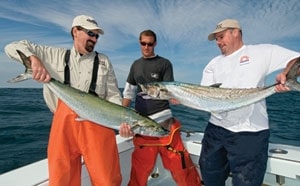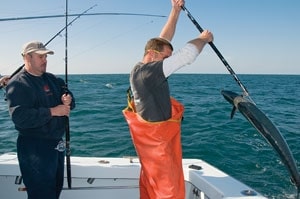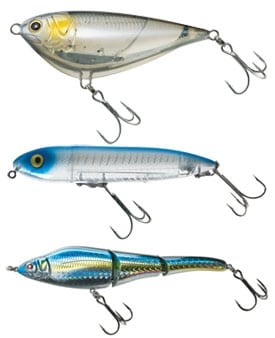
I arrived at the dock at 7:30 in the morning with my friends Darren Shepard and Marc Malkin to meet Capt. Dan Rooks and the crew of the Tuna Duck at Hatteras Harbor Marina, in North Carolina, and right away I got the feeling this wasn’t going to be just another fishing trip as I watched mates Mike Edwards and Marvin Aldridge load onto the boat a large plastic tub containing what could be described – at best – as a recreational gill net.
Rooks smiled when I asked him what the net was for, responding in his typical easy Carolina manner, “bait.”
We soon realized what he meant as we made our way out of Hatteras Inlet and north along the beach, to the site where a couple of other charter boats and even the well-known partyboat Miss Hatteras were getting in on the action. Singles and doubles of pelicans diving in the muddy water betrayed the presence of jumbo menhaden – prime forage for the big, late-season king mackerel roaming the Atlantic reefs off Cape Hatteras.
“The bait is spread out,” said Rooks. “Usually you can cast-net them, but this time of year, they aren’t really thick enough. So we set the gill net and then try to maneuver around, marking them on our fish finder and hoping to scare them into the net.”
My own experiences with menhaden (aka bunker or pogies) in Florida, Georgia and South Carolina had convinced me that they were delicate baitfish that didn’t take netting and handling very well. These Outer Banks, or OBX, versions – near three-quarter-pounders or better – proved me wrong. Edwards and Aldridge expertly struck the net, gently removing the big bunker from its mesh. After several sets, we finally had enough of the mega-liveys in the well to head offshore in search of our silver treasure: big kings.
Follow the Boats
Rooks, who has made a living as a waterman all of his life, is well in tune with the commercial fleet comprising the artisanal fishery that is the lifeblood of Hatteras Village.
“The commercial boys have been working a pretty good school of fish over some rough bottom in about 22 fathoms of water,” said Rooks. “And it looks like the weather is going to deteriorate as the day wears on. But we should be able to get in a pretty good half day of kingfishing.”
Suffice it to say Rooks’ idea of a good “half day” of kingfishing ranks right up there with as good a full day of kingfishing as you can have anywhere in the Southeast. The first bait in the water resulted in a 20-pounder – the smallest fish of the day. Over the next four hours, we landed a dozen fish, scaling to 32 pounds, and hooked at least that many more. Around 1 p.m., Capt. Rooks asked if we’d had enough – and we had. Although it’s not like me to leave fish while they’re biting, the impending cold front had caused us to change our travel plans; we had several hours ahead of us in the car to get to Norfolk, Virginia, and our awaiting flights.

Reluctantly, we headed back in. But not before picking up a couple of Rooks’ best tips for targeting big king mackerel.
Feed ‘Em Plastic
The caliber and quantity of fish we experienced at Hatteras convinced me to try casting some artificial topwater lures. They worked very well. I found the fish receptive to both Sebile’s Bonga Jerk Minnow and Magic Swimmer. Although we hooked quite a few fish while slow-trolling live baits and just putting the lures back in the spread, we also hooked quite a few by casting after hooking a fish on a live bait. For light-tackle enthusiasts, casting’s a great way to break up the day and something I’d highly recommend.
When most anglers think of Hatteras Village, they probably think of grander marlin and giant bluefin tuna. But the friendly, all-American village also boasts some of the best king mackerel fishing I’ve ever seen. Give it a shot. Chances are, you’ll be hooked like me – and I can’t wait to return.
***
Outer Banks, North Carolina
Late-season smoker kings on the Outer Banks offer anglers a variety of tackle options. The norm is 12- to 30-pound conventional live-bait rigs, but when the fish are schooling don’t be afraid to pull out light spinning rods armed with large swimming lures; big kings will hit them with a vengeance.
**

Rods:** Medium to medium-heavy 7-foot conventional or spinning rods with light tips that allow forgiveness on the treble hooks when a big fish slams a jumbo menhaden.
Reels: Conventional or spinning reels with 250-plus yards of capacity, to withstand long runs from smoker kings, some as big as 50 pounds.
Lines: 12- to 30-pound monofilament or braided line.
Leader: 4 or 5 feet of 50-pound fluorocarbon leader, topped off with a 36-inch section of 45- or 60-pound braided wire attached via a small ball-bearing swivel.
Baits: Jumbo live menhaden or snapper bluefish armed with two No. 4 or No. 6 Mustad 2x bronze trebles.
Artificials: Large swimming baits like Sebile’s Magic Swimmer (top); Heddon’s Super Spook (middle); or Sebile’s Bonga Jerk Minnow (bottom). Colors should mimic baitfish like menhaden, herring or mackerel.
***
Rigging Right
Rooks’ first trick is one I’ve adapted to my own fishing when live-baiting wahoo, kingfish and other toothy critters in the Florida Keys. He prefers a double treble-hook rig similar to those used by pros on the kingfish circuit. It’s not IGFA legal, but fishing a heavy charter season requires being a little innovative. Rooks and his crew like to pre-rig their leaders and pin them to a large piece of hard foam insulation. Rather than working with hard wire like most die-hard kingfishermen, he prefers a 36-inch length of noncoated braided wire with a No. 4 or No. 6 2x-strong treble hook knotted to one end with a figure-eight knot. If the baits are large, Rooks or Edwards then attaches the lead treble in the same manner, in line with the wire leader material via another figure-eight knot. This allows the rigs to be as flexible as possible with the varying lengths of baits the crew might use. The flexible braided wire is easy to work with and gives them disposal to dozens of rigs at a time on charters. They’ll finish the terminal end off with a small ball-bearing swivel that attaches to a 5-foot length of 50-pound fluorocarbon.
**Outer Banks, North Carolina
**
What: Big, late-season king mackerel.
When: October through December; mid-November is prime time.
Where: Hatteras Village on the Outer Banks. This quaint little fishing village features great accommodations at locally owned resorts like the Hatteras Marlin Motel (866-986-2141; www.hatterasmarlin.com), within easy walking distance of the Hatteras Harbor Marina (800-676-4939; www.hatterasharbor.com). Any serious blue-water angler wouldn’t want to miss this destination.
Who: Capt. Dan Rooks aboard the Tuna Duck, a 50-foot custom Carolina boat built by Capt. Buddy Canady in Manteo, North Carolina. The single-screw boat is comfortable even in rough sea conditions and has a great platform for up to six anglers. For more information, call 772-219-9592 or visit www.tunaduck.com.









